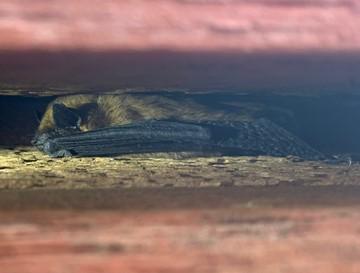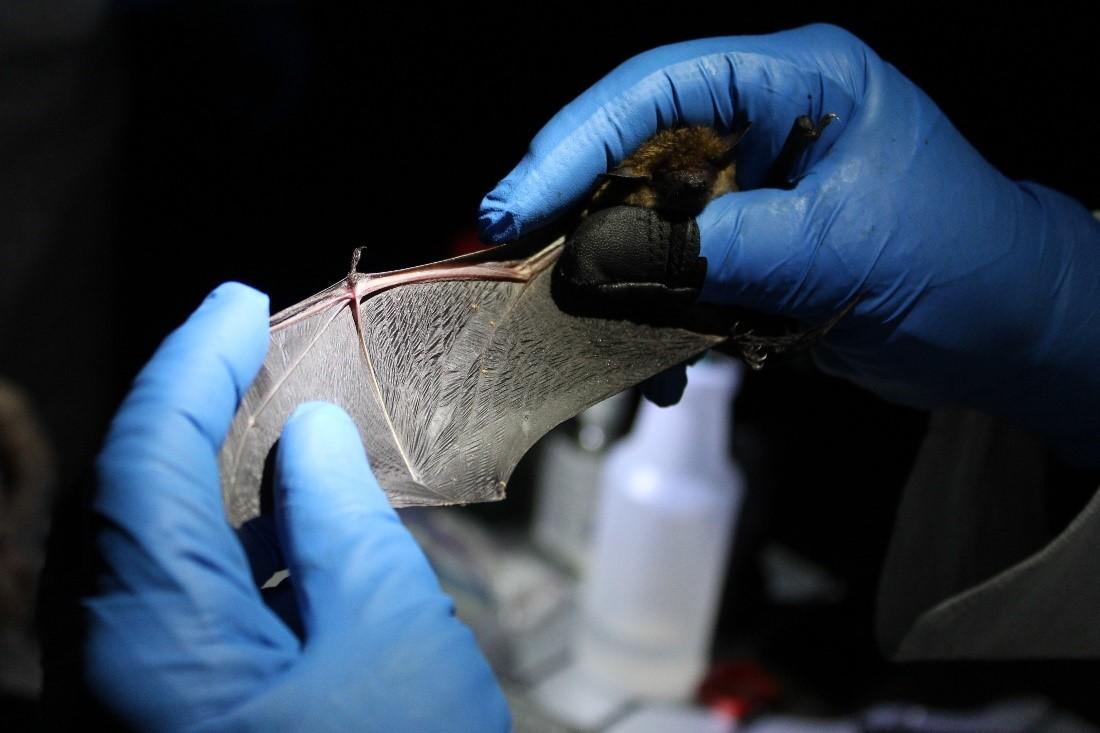Photos
Click to display full size or right-click to save to your device.
ARCHIVED NEWS RELEASE
This document is provided for archival purposes only. Archived documents
do not reflect current WDFW regulations or policy and may contain factual
inaccuracies.
News release Sept. 20, 2021
Abby Tobin, 360-999-7958; Rachel Blomker, 360-701-3101
OLYMPIA – An invasive fungus that causes white-nose syndrome, an often-fatal disease of hibernating bats, continues to spread in Washington. During spring and summer field work this year, scientists with the Washington Department of Fish and Wildlife (WDFW), in partnership and with funding from the U.S. Forest Service (USFS), detected the fungus or disease in at least three additional counties in the state.
“These recent confirmations of white-nose syndrome and the causative fungus in new areas of Washington are very concerning, as they provide evidence that the disease is spreading,” said Abby Tobin, white-nose syndrome coordinator for WDFW. “This eventually may lead to population declines in several bat species that are vulnerable to white-nose syndrome.”
White-nose syndrome is harmful to hibernating bats, but does not affect humans, livestock, or other wildlife. The disease is caused by the fungus Pseudogymnoascus destructans, which attacks the skin of hibernating bats and damages their delicate wings, making it difficult to fly. Infected bats often leave hibernation too early, which causes them to deplete their fat reserves and become dehydrated or starve to death.
Washington is home to 15 bat species that are important predators of night-flying insects. These bats benefit humans by eating tons of insects that can negatively affect forest health, commercial crops, and human health and well-being.
In March 2016, the first case of white-nose syndrome in the western U.S. was confirmed in a little brown bat (Myotis lucifugus) in King County. Since then, WDFW has confirmed over 100 cases of the disease in at least four bat species in the state. WDFW has confirmed white-nose syndrome in King, Chelan, Kittitas, and Pierce counties. In addition, the fungus that causes white-nose syndrome has been detected in Lewis, Mason, Snohomish, and Yakima counties.
A map showing fungus and white-nose syndrome detections in Washington is available online at https://wdfw.wa.gov/bats.
Summary of 2021 white-nose syndrome or fungus detections
Chelan County: The fungus that causes white-nose syndrome was first detected in Chelan County in May 2020 from bat guano (feces). In April 2021, a local resident reported a dead bat to WDFW found near Malaga, WA. Biologists observed signs suggestive of white-nose syndrome infection when collecting the bat. With funding support from the U.S. Fish and Wildlife Service, additional testing at the USGS National Wildlife Health Center confirmed the bat had white-nose syndrome. The bat species was either a Yuma myotis (Myotis yumanensis) or little brown bat, two common bat species that are visually hard to tell apart.

Mason County: During routine bat monitoring work in summer 2021, WDFW scientists coordinated with USFS personnel to collect swab samples from a group of bats on USFS property and noticed a big brown bat (Eptesicus fuscus) with clinical signs suggestive of white-nose syndrome. WDFW sent samples to the Oregon Veterinary Diagnostic Laboratory at Oregon State University’s Carlson College of Veterinary Medicine for testing. While the laboratory test results were inconclusive, the observed clinical signs lead researchers to suspect the bat had white-nose syndrome.
Yakima County: In coordination with USFS personnel, WDFW scientists collected guano samples in late spring 2021 from a bat colony showing no obvious signs of disease on USFS property near Rimrock Lake. Testing at the USGS National Wildlife Health Center confirmed the presence of the fungus that causes white-nose syndrome. The bat genus was Myotis, but the specific species is unknown.
How to help
WDFW urges people to not handle wild animals, especially if they appear sick or are found dead.
If you find sick/dead bats, groups of bats, or notice bats acting strangely, such as flying outside during the day in winter or spring, please report your sighting online at https://wdfw.wa.gov/bats or call WDFW at 360-902-2515.
Even though the fungus is primarily spread from bat-to-bat contact, humans can unintentionally spread it as well. People can carry fungal spores on clothing, shoes, or recreation equipment that touches the fungus. To learn more about the disease and the national white-nose syndrome response, and to get the most updated decontamination protocols and other guidance documents, visit www.whitenosesyndrome.org.
For more information on Washington bats, visit https://wdfw.wa.gov/species-habitats/living/species-facts/bats.
Monitoring the spread of white-nose syndrome
WDFW collaborates with partners, including the USFS, Bureau of Land Management, U.S. Fish and Wildlife Service, Washington State Department of Health, wildlife rehabilitators, and others to collect samples from bats and the areas where they live around the state. This proactive surveillance work helps scientists detect the presence of the fungus that causes white-nose syndrome and track its spread.
WDFW works to preserve, protect and perpetuate fish, wildlife and ecosystems while providing sustainable fish and wildlife recreational and commercial opportunities.
